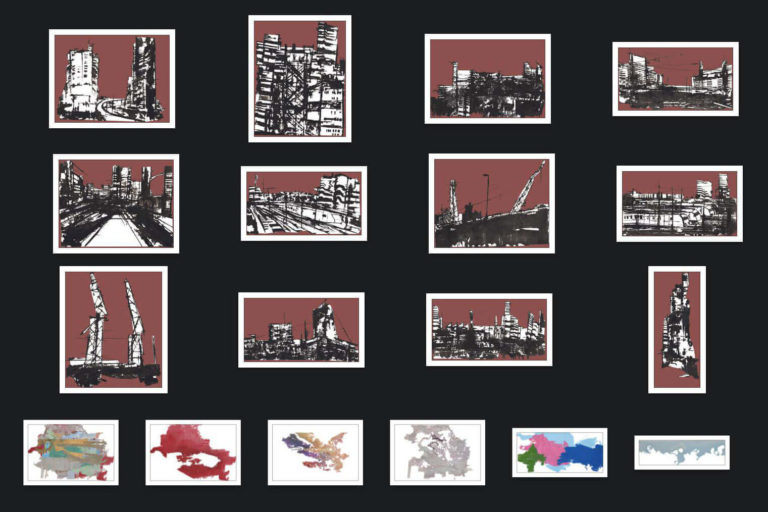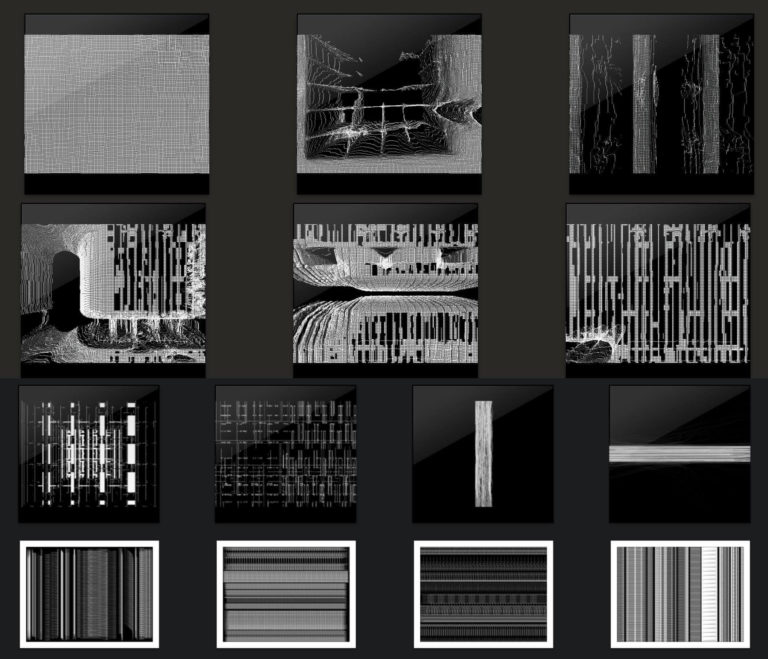Francesco Barbieri&Nicola Buttari
利维坦Leviathan
我很难对流行疫情有一个清晰的概念:因为这是我们生活中第一次发生这样的事情。一开始我看到疫情在中国发生看起来很严重,但这离我的日常生活还很远。几个月后,疫情蔓延到了意大利。一开始我很担心,后来我慢慢的习惯了,并且很好地适应了这种情况。从艺术方面来说,我很享受所有的项目和演出都被推迟的事实。我认为这是我们社会普遍存在的一个问题:生活节奏太快。对创作艺术品没有任何压力,让我有更多的自由去创作。我创作了一些普通的绘画,没有想太多,只是一种训练,就像是练习一样。同时,我也开始了一些试验,以使我能够继续进化。
我的工作通常是把在街上找到的元素融合到画布上。这是我作为涂鸦作家这个身份背景的一个习惯。在画布上,我画满了建筑物和铁路的风景。通过增加情感的触动,我试着用这些元素作为一个很好的借口来谈论我们的社会,我们的感情,以及我们周围的世界。我认为疫情造成了一个悲惨的局面,所以我试图在这一时期的作品中传达以下思想和情感:恐惧、集体恐慌、胁迫和反乌托邦。这些是我在作品中经常提到的一些主题,但突然间它们变得比平时更重要了。
—
在我看来,艺术家的角色是提问者,这就是为什么我要处理诸如痛苦、控制、恐惧、安全、大众消费、污染和反乌托邦等话题。这就是为什么当我开始根据我对流行疫情的经验来思考一项工作时,我没有一个具体的方向可以选择:一切都已经存在了!
取而代之的是,我的挑战是提交一些可以克服病毒造成的社会隔离,并且在通过移动屏幕或计算机显示器欣赏时可以很好地工作的东西。但同时,如果需要的话,我也想要一些能以身体形式出现的东西。
然后我决定重读《利维坦》(Leviathan),这是一部与视频艺术家尼古拉·布塔里(Nicola Buttari)合拍的作品。最初,这是一个在皮亚乔博物馆的视频装置。在博物馆里,它被投影到三个巨大的墙壁大小的屏幕上,给观察家留下了被一个城市包围的印象,这个城市也是一个巨大的生命体——呼吸和发出声音。当你通过电话或电脑看到这些作品时,你的身体并没有包围你,但你仍然可以将城市视为一个巨大的生命体,一个正在发生事情的社区:你有暗淡的时刻,你可以感受到紧张、痛苦和其他强烈的情绪——我认为这正是我们在经历的疫情。
Francesco Barbieri
这个装置由 3个屏幕组成,这个视频是投影在中央屏幕上的视频之一。
链接如下:http://www.proformaveodesign.com/leviathan/
这个视频装置代表了一个不断变化的有机大都市,一种巨大的身体,它的移动,呼吸和步伐与无数的无形的居民一致。为了做到这一点,我从弗朗西斯科 (Francesco) 的绘画开始;我让他画了一系列的建筑,我把它们剪贴起来,创造出一幅巨大的人类景观。在视频艺术作品中,可以看到一些 弗朗西斯科 的建筑和我用来制作的色斑图纹。
我选择了一些抽象的视觉产品作为图案或有机运动图形来混合在构图中。这些材料来自我以前在电子音乐活动中的一些现场视觉表演,与 弗朗西斯科 的风格结合得很好。
所以,受日本漫画 Akira 的启发,我和 弗朗西斯科达成一致,创造了一个有机的大怪物。
为了完成它,我混合了很多噪音以产生一个黑暗的声音设计,代表这个大都市的声音。
Nicola Buttari
It’s hard to have an idea about the pandemic: it’s the very first something like this is happening in our lives. When at first I saw what was happening in China, it looked serious. But it was still really far from my daily life. After a couple of months, the pandemic reached Italy. In the beginning, I’ve got very worried. Then, bit by bit, I’ve got used to it and adapted to the situation pretty well. From the artistic side, I somehow enjoyed the fact that all the projects and shows were delayed . I think that’s a problem in general of our society: The pace of life is too fast. Not having any pressure about producing artworks gave me eventually more freedom. I created some regular paintings without thinking too much, just as a form of training, like they were exercises. Also I started to experiment a bit, in ways that allow me to keep on evolving.
My work generally is about bringing on the canvas the energy that you find in the street. It’s a direct consequence of my background as a graffiti writer. On canvas, I paint landscapes filled with buildings and railways. By adding an emotional touch, I try to use those elements as a good excuse to talk about our society, our feelings, and the world around us. I think that the pandemic created a tragic situation, so I tried to convey the following ideas and emotions in the works done in this period: Fear, collective panic, coercion, and dystopia. These are some of themes that I usually address in my works – but suddenly they became even more important.
—
In my opinion the role of the artist is to ask questions, and that’s why I play with topics such as suffering, control, fear, safety, mass consumption, pollution, and dystopia. That’s why I didn’t have a specific direction to choose when I started to think about a work based on my experience of the pandemic: Everything was already there!
Instead, my challenge was to submit something that could beat the social isolation imposed by the virus, and could function well when appreciated via a mobile screen or a computer monitor. But at the same time, I wanted also something that could take physical form, if needed.
I then decided to readapt Leviathan, a work co-produced with video artist Nicola Buttari. Originally, it was a video installation at the Museo Piaggio. At the museum, it was shown projected onto three huge wall-size screens, which gave the observer the impression of being surrounded by a city that was also a big living organism – breathing and making sounds. When seen through a phone or a computer, the work doesn’t physically surround you, but you still can perceive the city as a big living being, a community where things are happening: you have bleak moments, lightenings, you can feel tension, pain, and other strong emotions – and I think that this is exactly what we are experiencing during the pandemic.
Francesco Barbieri
This installation is made up of 3 screens, and this video is one of those projected in the central one.
Here the link: http://www.proformavideodesign.com/leviathan/
This video installation represents an organic metropolis in continuous change, a kind of huge body that moves, breathes, and strides in unison with its innumerable and invisible inhabitants. To do this, I started from Francesco’s drawing; I asked him to draw a series of buildings and I cut out and pasted them to create a big anthropic landscape. In the video artwork you can see some of Francesco’s buildings and color stains that I used for the production.
Then I selected some of my abstract visual designs as patterns or organic motion graphics to mix in the composition. This materials come from some of my old live visual performances in electronic music events, and well mix with Francesco’s style.
So, inspired by the Japanese manga Akira, and in agreement with Francesco, I created an organic big monster.
To complete it, I mixed a lot of noises to produce a dark sound design that represents the voice of this metropolis.
Nicola Buttari
在艺术品中找到意义
Finding meaning in the artwork
利维坦
邓艺卿
在你的心中,你生活的城市是什么样子的?带着这个问题,让我们先走进艺术家弗朗西斯科·巴比耶里(Franceso Barbieri)和尼古拉·布塔里(Nicola Buttari)心中的世界,感受他们塑造的巨大的生命体——利维坦,一个有机的城市。
城市陪伴着我们度过忙碌的日子,而这一次,我们成为了它的倾听者
这是一个结合了Barbieri的后涂鸦绘画和Buttari的视频艺术的视频作品。它向我们展现了一个巨大的有生命力的城市。它和我们一样,会呼吸和发出声音,会表达喜怒哀乐。无数个点、线、面构成了城市建筑的剪影,这是Barbieri的后涂鸦绘画的基本组织原则。通过光谱辐射的某种变化,建筑物呈现出不同颜色的装饰。同时,随机的音乐背景更容易让人们沉浸其中,产生丰富的情感变化。仔细听,你可以听到雷声、雨滴声、装修声等等城市的声音,仿佛城市在说话。城市陪伴着我们度过忙碌的日子,而这一次,我们成为了它的倾听者。通过不同颜色的变化、动效的频率快慢、多种声音的缓急,你可以感受到紧张、痛苦和其他强烈的情绪,城市有暗淡的时刻,也会有光明的时刻,这正是我们在经历疫情时,所能体会到的。
Barbieri的绘画直接表达了他内心的声音
Barbieri和Buttari通过关注城市环境本身,达到了传播这种情绪混乱的目的。Barbieri的绘画直接表达了他内心的声音:通过混合世界各地的景观元素,他解构了城市的内在本质。看他的作品风格,我们发现与野兽派有着相似之处。野兽派的作品创作原则为简练粗犷的线条、大面积纯色的平涂。野兽派认为绘画是自我情感的真实表达,即个人主观意识的真实流露。Barbieri同样善于运用粗犷豪放的线条,大面积的鲜艳色块,来表达他内心对城市的真实感受,并展示城市不是一个由混凝土组成的惰性的大集团,而是一个至关重要的东西。Buttari对Barbieri设计的视频处理增强了装置的表现力。他收集了城市每天的噪音和其他声音,通过将它们与数字图像混合,产生了利维坦。他让城市像人一般,可以行动,可以说话,带给我们丰富的体验。
Barbieri认为:““城市是反映我们自己生活、生命和情感体验的一种存在形式。”城市就像《圣经》中的庞大怪兽利维坦,不管你接不接受它的存在,我们终究和城市一起呼吸,一起经历情绪的变化,一起渡过灾难,寻找光明。
Leviathan
By Deng Yiqing
In your heart, in what kind of city would you like to live? With this question in mind, we first step into the world created by artists Francesco Barbieri and Nicola Buttari. There, we can feel the huge living body that they created: Leviathan, an organic city.
“Through these urban voices, the city is talking”
This is a video artwork that combines Barbieri’s post-graffiti painting and Buttari’s video art: Sounds and dynamic effects mingle and enrich the visual forms. Leviathan shows us a huge and vigorous city. Just like us, it breathes, moves, and makes noises. Its living quality imbues this installation with distinct expressive power. Numerous points, lines, and surfaces constitute the silhouette of the urban architecture, which is the organizing principle of Barbieri’s post-graffitism. The buildings appear as decorated with different colors dynamically changing through some kind of shift in the spectral radiation. At the same time, the stochastic and nose filled musical background significantly contribute to expressing the complex emotions that the piece conveys. Listen carefully: You will hear thunders, raindrops, and many other city sounds. Through these urban voices, the city is talking. In our busy days, it listens to us, but this time, with an unexpected inversion of roles, we become the city’s listeners. The color switching, the change in dynamic frequencies, and the constant evolution in the speed of those multiple voices are key to charge the installation with tension, pain, and other strong emotions. There are dark and bright moments in the city, which is exactly what we can experience during the pandemic.
“Barbieri’s drawing appears as a direct utterance of his inner voice”
Barbieri and Buttari achieve the goal of transmitting this emotional turmoil by focusing on the urban environment itself. Barbieri’s drawing appears as a direct utterance of his inner voice: By mixing elements of landscapes from around the world, he deconstructs the city’s inner nature. In his style, we find echoes of Fauvism. The artistic principles animating this genre have to do with the simplicity and roughness of basic lines and the flatness of the pictorial space realized through the use of solid colors. Fauvists believe that painting is an unmediated expression of the self, that is, the artistic realization of one’s subjective consciousness. Just like Fauvists, Barbieri here exploits bold lines and large areas of bright colors as tools to express his real feelings about the city – and to show the city not as an inert conglomerate of concrete, but as something vital. Buttari’s video manipulation of Barbieri’s design enhances the installation’s expressive power. He collected the daily noises and sounds of the city and, by mixing them with digital graphics, he gave rise to Leviathan. This city is just like a person: It is able to act, to speak, and to influence our experiences.
“City is a form of existence that reflects our own life and our emotional experience,” Barbieri says. But this city is just like the Leviathan, the huge biblical monster. Whether you accept it or not, we will eventually breathe together with the city, experience emotional changes together with it, survive disasters together, and look for a new light.
Francesco Barbieri
弗朗西斯科·巴比耶里(Franceso Barbieri)1976年生于意大利比萨,是一位从事当代后涂鸦创作的国际艺术家。
他致力于在画布上绘画,是欧洲涂鸦界的重要人物。近年来,他探索借鉴了许多典型民间涂鸦的题材。目前,它的制作主要集中在城市场景的构建上,通常火车和铁路是中心元素。在他的作品中,他探索了城市生活的“边缘”,代表了在城市的地理和社会边界上可以找到的那些无人居住的土地。巴比耶里 以其独特的视觉语言,在绘画中传达了他多年来探索的街头情感。事实上,旅行已成为他艺术的一个基本元素。在过去的二十年里,他定期访问美国的纽约和旧金山,欧洲的柏林和斯德哥尔摩,中国的北京、上海和南京,发现这些城市最隐蔽的角落。
Francesco Barbieri (born in Pisa, Italy, 1976) is an internationally recognized artist working in contemporary post-graffitism.
With his work on canvas he has explored various topics borrowed from graffiti folklore. His production focuses on the creation of urban landscapes where the train and the railroad are often central elements. In his works he explores “the margins” of urban life, representing those no-man lands which one can find at the geographical and social borders of the city. With his unique visual language, Barbieri aims at conveying those same feelings that he experienced in the streets and that he has been exploring for years. Travelling has become one of the essential elements of his art: he visited several times, among others, Berlin and Stockholm in Europe, New York and S. Francisco in America, Beijing and Nanjing in China, with the desire to discover the hidden lives of modern metropolises.
Nicola Buttari
尼古拉·布塔里(Nicola Buttari)是一个视频设计师和投影地图艺术家,主要为博物馆和展览工作。他的艺术生涯始于视觉艺术家,曾在意大利北部和中部最好的俱乐部和电子节上表演。在瑞士,他学习投影制图和生成艺术。回到意大利后,他专门从事视频地图制作、知名品牌和公司的互动装置设计、博物馆视频装置设计以及剧院、舞蹈和歌剧的虚拟场景设计。
2016年,在博洛尼亚美术馆(Arte Firera Bologna)期间,他与国际艺术家安德烈科(Andreco)合作制作了一个视频装置,同年夏天,他为利沃诺的多媒体“港口中心”port center博物馆制作了一幅复杂的地图。秋天,他开始与戏剧和舞蹈合作,为弗朗西斯卡·塔洛齐的《自然之翼》创作了一部身临其境的剧本,并为兰迪协会举办的“反对妇女国际日”创作了一场互动舞蹈表演。
通过“YouDigital”项目,它促进了与视频地图和与观众互动相关的培训会议。他与他的合作伙伴曼努埃拉合作,在博洛尼亚的欧洲变性人节和随后的夏天的拉贾蒂科“艺术解决方案”节上提出了第一个项目“卡利普索”,从而构思了“互动照相”的概念,由建筑师阿尔贝托·巴塔里尼(Alberto Bartalini)编辑的、安德烈·波切利(Andrea Bocelli)创作的“西伦齐奥教堂(Teatro del Silenzio)”著名的附带活动。
2017年,他继续从事视频布景师的工作,在失光剧场
(Teatro dello Scompiglio Lucca)参加“Walter Wendy Carlos”节目,3月,他被Goldoni剧院聘用,负责由阿尔贝托·韦罗内西大师执导的Giacomo Puccini“Manon Lescaut”的虚拟布景。他与艺术家弗朗西斯科·巴比耶里(Francesco Barbieri)和建筑师卡洛·阿泽尔(Carlo Arzelà)编辑的阿莱安德罗·朗卡拉(Aleandro Roncarà)合作,连续两年在庞泰德拉的皮亚乔博物馆(Piaggio museum)实现了两个沉浸式装置。
2017年底,他开始与Versiliadanza和佛罗伦萨的Cantiere Florida剧院合作,在那里他制作了“Egon”的虚拟场景图,这是一个关于克里姆坦德·席勒的互动舞蹈节目,以及“In sezione aurea”,这是一个专注于达芬奇的表演。
同年夏天,他在托斯卡纳卡斯塔涅托卡杜奇(Tuscany Castagneto Carducci)一个中世纪小村庄的街头节日“Sognambula”工作。
2018年夏天,他与同事奇蒂合作,创作了两部重要的视频装置《莫迪利亚尼歌剧》,在卡塞塔皇宫曝光,并为罗马博览会“Ecoc 2018”技术国际会议进行了大型投影。
2019年,他加入了一个专业团队,成立了“IMMERSIVA s.r.l.”公司,在利沃诺历史中心建设一个多大型展览中心。
2020年1月,他与 Immersiva 团队一起意识到,为庆祝艺术家阿梅迪奥·莫迪利亚尼(Amedeo Modigliani)百年诞辰绘制了一幅重要的投影图。
Nicola Buttari is a video designer and projection mapping artist working for events, museums, and shows. His artistic career begins as a visual artist, performing in the best clubs and electronic festivals along northern and central Italy. In Switzerland, he learns the technique of projection mapping and generative art. Back in Italy, he specializes in video mapping, interactive installations for prestigious brands and companies, museum video installations and virtual scenography for theater, dance and opera.
In 2016 during Arte Firera Bologna, he collaborated with the international artist Andreco on a video installation, and in the same summer he created a complex mapping for the multimedia “port center” museum in Livorno. In the autumn he began his collaboration with theater and dance, creating an immersive screenplay for the show “Fin dentro la natura” by Francesca Talozzi, and an interactive dance performance for the international day of violence against women by Randi association.
With the “you-digital” project, it promotes training meetings related to video mapping and interaction with viewers. In collaboration with his partner Manuela he conceived the concept of “interactive photomapping” by presenting the first project ”Calypso”, during the European Transgender Festival in Bologna, and the following summer in the Lajatico “Artinsolite” festival, a famous collateral event at the “Teatro del Silenzio” by Andrea Bocelli curated by the architect Alberto Bartalini.
In 2017 he continues the work of video scenographer and participates in the show “Walter Wendy Carlos” (sound notes for transforming) at the Teatro dello Scompiglio Lucca, and in March he is hired by the Goldoni theater in Livorno to take care of the virtual scenography of the “Manon Lescaut” of Giacomo Puccini directed by Maestro Alberto Veronesi. He realizes two immersive installations for two consecutive years at the Piaggio museum in Pontedera in collaboration with the artists Francesco Barbieri and Aleandro Roncarà, curated by the architect Carlo Arzelà.
At the end of 2017 he begins the collaboration with Versiliadanza and the Cantiere Florida theater in Florence where he produces the virtual scenography of “Egon”, an interactive dance show about Klimtand Schile, and “In sezione aurea”, a performance focused on Leonardo daVinci.
In the same summer he worked for “Sognambula” a street festival in a little medieval village in the Tuscany Castagneto Carducci.
In the summer of 2018, in collaboration with his colleague Chiti, he created two important video installations,“Modigliani opera”, exposed at the Royal Palace of Caserta and a mega projection for the international meeting of “Ecoc 2018” technologies at the Rome fair.
In 2019 he joined a group of professionals and founded the company “IMMERSIVA s.r.l.” for the construction of a multi-sensorial exhibition center in the historic center of Livorno.
In January 2020 he realized, with the Immersiva team, an important projection mapping for the celebration of the centenary of the artist Amedeo Modigliani.

